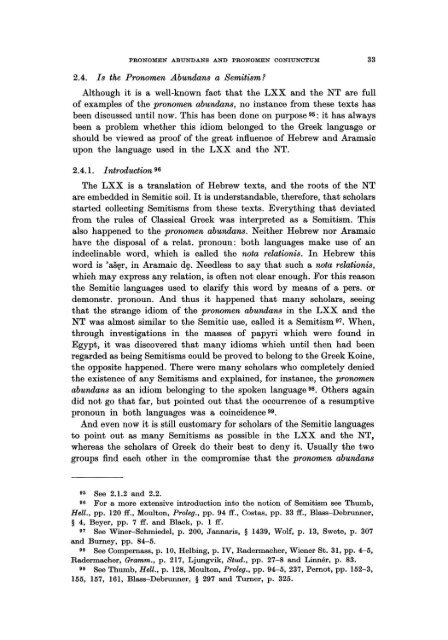Pronomen Abundans and Pronomen Coniunctum. A ... - DWC
Pronomen Abundans and Pronomen Coniunctum. A ... - DWC
Pronomen Abundans and Pronomen Coniunctum. A ... - DWC
Create successful ePaper yourself
Turn your PDF publications into a flip-book with our unique Google optimized e-Paper software.
PRONOMEN ABUNDANS AND PRONOMEN CONIUNCTUM 33<br />
2.4. Is the <strong>Pronomen</strong> <strong>Abundans</strong> a Semitism?<br />
Although it is a well-known fact that the LXX <strong>and</strong> the NT are full<br />
of examples of the pronomen abundans, no instance from these texts has<br />
been discussed until now. This has been done on purpose 95: it has always<br />
been a problem whether this idiom belonged to the Greek language or<br />
should be viewed as proof of the great influence of Hebrew <strong>and</strong> Aramaic<br />
upon the language used in the LXX <strong>and</strong> the NT.<br />
2.4.l. Introduction 96<br />
The LXX is a translation of Hebrew texts, <strong>and</strong> the roots of the NT<br />
are embedded in Semitic soil. It is underst<strong>and</strong>able, therefore, that scholars<br />
started collecting Semitisms from these texts. Everything that deviated<br />
from the rules of Classical Greek was interpreted as a Semitism. This<br />
also happened to the pronomen abundans. Neither Hebrew nor Aramaic<br />
have the disposal of arelat. pronoun: both languages make use of an<br />
indeclinable word, which is called the nota relationis. In Hebrew this<br />
word is 'as~r, in Aramaic d~. Needless to say that such a nota relationis,<br />
which may express any relation, is of ten not clear enough. For this reason<br />
the Semitic languages used to clarify this word by means of a pers. or<br />
demonstr. pronoun. And thus it happened that many scholars, seeing<br />
that the strange idiom of the pronomen abundans in the LXX <strong>and</strong> the<br />
NT was almost similar to the Semitic use, called it a Semitism 97. When,<br />
through investigations in the masses of papyri which were found in<br />
Egypt, it was discovered that many idioms which until then had been<br />
regarded as being Semitisms could be proved to belong to the Greek Koine,<br />
the opposite happened. There were many scholars who completely denied<br />
the existence of any Semitisms <strong>and</strong> explained, for instance, the pronomen<br />
abundans as an idiom belonging to the spoken language 98. Others again<br />
did not go that far, but pointed out that the occurrence of a resumptive<br />
pronoun in both languages was a coincidence 99.<br />
And even now it is still customary for scholars of the Semitic languages<br />
to point out as many Semitisms as possible in the LXX <strong>and</strong> the NT,<br />
whereas the scholars of Greek do their best to deny it. Usually the two<br />
groups find each other in the compromise that the pronomen abundans<br />
95 See 2.1.2 <strong>and</strong> 2.2.<br />
96 For a more extensive introduction into the notion of Semitism see Thumb,<br />
HeU., pp. 120 ff., Moulton, Proleg., pp. 94 ff., Costas, pp. 33 ff., Blass-Debrunner,<br />
§ 4, Beyer, pp. 7 ff. <strong>and</strong> Black, p. 1 ff.<br />
97 See Winer-Schmiedel, p. 200, Jannaris, § 1439, Wolf, p. 13, Swete, p. 307<br />
<strong>and</strong> Burney, pp. 84-5.<br />
98 See Compernass, p. 10, Helbing, p. IV, Radermacher, Wiener St. 31, pp. 4-5,<br />
Radermacher, Gramm., p. 217, Ljungvik, Stud., pp. 27-8 <strong>and</strong> Linnér, p. 83.<br />
99 See Thumb, HeU., p. 128, Moulton, Proleg., pp. 94-5, 237, Pernot, pp. 152-3,<br />
155, 157, 161, Blass-Debrunner, § 297 <strong>and</strong> Turner, p. 325.
















